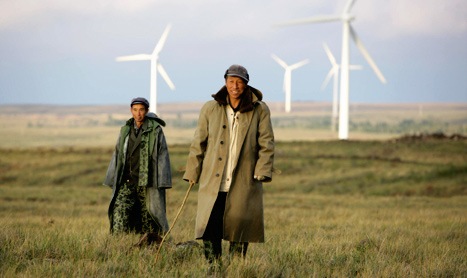China’s Energy Paradox
20 Sep, 2010 09:47 am
China is both the biggest user of dirty energy and clean energy; home to the world’s first eco-cities and also some of the world’s most polluted; host to the greatest number of new oil-dependent cars but third in terms of producing alternatives to petroleum.

For example, in the electricity sector more than three-quarters of all coal-fired power plants around the world were built in China last year, enabling coal to contribute to about 80 percent of Chinese electricity generation. China is currently constructing the equivalent of two 500 megawatt (MW) coal-fired plants per week, or a capacity comparable to the entire power grid in the United Kingdom every year. The resultant increases in greenhouse gas emissions from the coal plants added to the Chinese grid in the last five years will already offset all of the gains made by the Kyoto protocol and collective voluntary efforts around the world over the same period.
Yet in 2009 China also added 37,000 MW of renewable power capacity, more than any other country, and it led the world with the largest amount of renewable energy capacity already installed. China was the top market for new additions of wind energy, installing 13,800 MW of capacity. It was also first in the installations and installed capacity for solar hot water heaters.
In terms of cities, the State Council openly advocated the "energetic establishment" of "eco-provinces" and "eco-cities" in 2000 and legislated the Cleaner Production Promotion Law and the Environmental Impact Assessment Law in 2002 to make existing cities safer and cleaner. The State Council also enacted the Energy Conservation Law in 2008 to hold officials accountable for implementing environmental standards.
As a result, a slew of ambitious energy- and environmentally-friendly urban initiatives were announced. Tianjin eco-city would see two-thirds of all waste recycled by its inhabitants and driving discouraged. Dongtan, near Shanghai, would virtually outlaw cars and enforce rigorous building efficiency standards. Other eco cities and villages could include Xiangji town in Xinjiang, and Huangbaiyu in Liaoning.
Yet in 2008 only one percent of China's 560 million city dwellers breathed air considered safe by the European Union . Two-hundred-ninety-seven of the largest 300 Chinese cities did not meet the minimal environmental standards for ambient air pollution set by the United States. The World Bank similarly estimated that the economic burden of premature mortality associated with air pollution was greater than one percent of Gross Domestic Product (GDP).
Lastly, in the transport sector, China became the number one country for the production and sales of gasoline-powered automobiles in the world, encouraged by government subsidies and support to the industry to create jobs. Yet less than 5 percent of the Chinese actually own an automobile, and the government heavily promotes mass transit and alternative fuels such as natural gas and ethanol. Indeed, in 2009 China jumped into third place for global ethanol production, surpassing Canada and France.
These trends reveal a contrast between two future Chinas. One seeking sustainable economic development through energy efficiency, frugality, and renewable energy resources. And another overwhelmingly dependent on pollution, waste, and nonrenewable energy sources to drive economic growth.
How are we to make sense of these conflicting trends?
One explanation is that there is no such thing as a unified national Chinese energy policy. Instead, there are many different energy policies, enacted at different times by different parties for different reasons. The result is a labyrinthine and complicated governance structure, an energy related bureaucracy notorious for being highly fragmented, inefficient, and poorly coordinated. The responsibility for energy pricing, permitting and approval of projects, oversight of state energy companies, and adjustment of electricity rates are spread across many ministries and agencies, to say nothing of the jurisdiction for environmental, health, transport, and urban policy. Moreover, most agencies lack the capacity and the authority to carry out their duties effectively.
No overarching theme or principle therefore guides Chinese planners, and the country instead appears wedded to a portfolio approach that pushes a variety of technologies and systems, even those that tradeoff with each other, to appease as many diverse stakeholders as possible.
A second, and more worrying explanation, is that the twin goals of sustainability, underpinned by clean energy, and economic development, underpinned by dirty energy, are inconsistent. President Hu Jintao famously committed the country to quadrupling its GDP from 2000 to 2020 and the Chinese economy is currently the second largest in the world. But it is first in greenhouse gas emissions, demonstrating inefficient production and manufacturing and complete dependence on carbon-belching coal, oil, and natural gas. In other words, from an energy standpoint the Chinese economy may be getting bigger, but it is not getting better. It could become locked in and addicted to carbon intensive industries and energy sources just like its Western counterparts.
Ultimately, the world's largest source of greenhouse gases and one of its largest energy consumers is running at full steam ahead but without a rudder. The current Chinese energy strategy represents more a bundle of technologies randomly juxtaposed together than any comprehensive and coherent energy vision. The result will invariably be more fragmentation, inconsistency, and paradoxical trends relating to energy, not less.
-
12/12/12
“Peak Oil” is Nonsense… Because There’s Enough Gas to Last 250 Years.
-
05/09/12
Threat of Population Surge to "10 Billion" Espoused in London Theatre.
-
05/09/12
Current Commentary: Energy from Nuclear Fusion – Realities, Prospects and Fantasies?
-
04/05/12
The Oil Industry's Deceitful Promise of American Energy Independence
-
14/02/12
Shaky Foundations for Offshore Wind Farms







 Read more
Read more